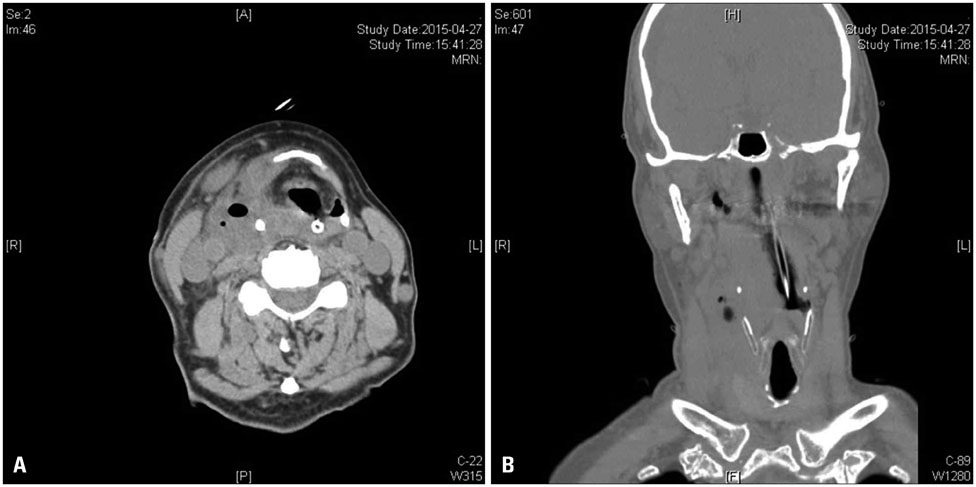J Cardiovasc Ultrasound.
2015 Sep;23(3):181-185. 10.4250/jcu.2015.23.3.181.
A Rare Case of Iatrogenic Deep Neck Infection Secondary to Hypopharyngeal Injury Caused by the Transesophageal Echocardiography
- Affiliations
-
- 1Division of Cardiology, Department of Medicine, Cardiovascular Imaging Center, Samsung Medical Center, Sungkyunkwan University School of Medicine, Seoul, Korea. s.woo.park@samsung.com
- 2Department of Radiology, Cardiovascular Imaging Center, Samsung Medical Center, Sungkyunkwan University School of Medicine, Seoul, Korea.
- 3Mayo Clinic College of Medicine, Rochester, MN, USA.
- KMID: 2068729
- DOI: http://doi.org/10.4250/jcu.2015.23.3.181
Abstract
- Transesophageal echocardiography (TEE) is considered relatively safe but semi-invasive. The hypopharyngeal and esophageal injury is infrequent complication of TEE but could be serious, even life-threatening. We present a case of a 74-year-old man who experienced a deep neck infection secondary to hypopharyngeal injury following TEE. The diagnosis was made because of the subcutaneous emphysema developed 3 hours after TEE. In spite of antibiotics therapy with prolonged fasting, a right parapharyngeal and retropharyngeal abscess was developed 5 days later. With ultrasound-guided drainage of abscess and continuous antibiotic treatment, infection was controlled. The patent underwent mitral valve repair after 14 days of antibiotic therapy. The patient recovered uneventfully. For cardiologists performing TEE, it is required to know complications and their risk factors to minimize hypopharyngeal and esophageal injury.
Keyword
MeSH Terms
Figure
Reference
-
1. Hilberath JN, Oakes DA, Shernan SK, Bulwer BE, D'Ambra MN, Eltzschig HK. Safety of transesophageal echocardiography. J Am Soc Echocardiogr. 2010; 23:1115–1127. quiz 1220-12. Khandheria BK, Seward JB, Tajik AJ. Transesophageal echocardiography. Mayo Clin Proc. 1994; 69:856–863.3. Min JK, Spencer KT, Furlong KT, DeCara JM, Sugeng L, Ward RP, Lang RM. Clinical features of complications from transesophageal echocardiography: a single-center case series of 10,000 consecutive examinations. J Am Soc Echocardiogr. 2005; 18:925–929.4. Seward JB, Khandheria BK, Oh JK, Freeman WK, Tajik AJ. Critical appraisal of transesophageal echocardiography: limitations, pitfalls, and complications. J Am Soc Echocardiogr. 1992; 5:288–305.5. Daniel WG, Erbel R, Kasper W, Visser CA, Engberding R, Sutherland GR, Grube E, Hanrath P, Maisch B, Dennig K, et al. Safety of transesophageal echocardiography. A multicenter survey of 10,419 examinations. Circulation. 1991; 83:817–821.6. Bakhos D, Cottier JP, Beutter P, Morinière S. Hypopharyngeal perforation: an unusual complication of transesophageal echocardiography. Ear Nose Throat J. 2011; 90:E1–E2.7. Brinkman WT, Shanewise JS, Clements SD, Mansour KA. Transesophageal echocardiography: not an innocuous procedure. Ann Thorac Surg. 2001; 72:1725–1726.8. Lecharny JB, Philip I, Depoix JP. Oesophagotracheal perforation after intraoperative transoesphageal echocardiography in cardiac surgery. Br J Anaesth. 2002; 88:592–594.9. Massey SR, Pitsis A, Mehta D, Callaway M. Oesophageal perforation following perioperative transoesophageal echocardiography. Br J Anaesth. 2000; 84:643–646.10. Hinojar AG, Díaz Díaz MA, Pun YW, Hinojar AA. Management of hypopharyngeal and cervical oesophageal perforations. Auris Nasus Larynx. 2003; 30:175–182.11. Aviv JE, Di Tullio MR, Homma S, Storper IS, Zschommler A, Ma G, Petkova E, Murphy M, Desloge R, Shaw G, Benjamin S, Corwin S. Hypopharyngeal perforation near-miss during transesophageal echocardiography. Laryngoscope. 2004; 114:821–826.12. Sainathan S, Andaz S. A systematic review of transesophageal echocardiography-induced esophageal perforation. Echocardiography. 2013; 30:977–983.
- Full Text Links
- Actions
-
Cited
- CITED
-
- Close
- Share
- Similar articles
-
- Pyriform Sinus Perforation with Deep Neck Infection Caused by Transesophageal Echocardiography during Coronary Artery Bypass Grafting : A case report
- Deep Neck Infection Caused by Infected Dentigerous Cyst: A Case Report
- Iatrogenic Aortic Dissection Following Mitral Valve Replacement: A case report
- Transesophageal Echocardiography and Its Role in Intraoperative Echocardiography
- Horseshoe-like Shaped Atrial Septal Defects Confirmed on Three-Dimensional Transesophageal Echocardiography






